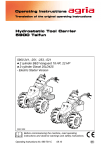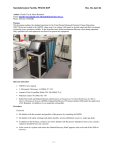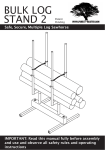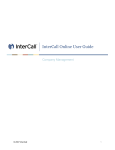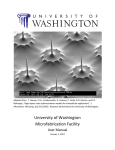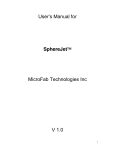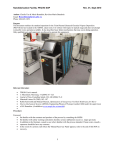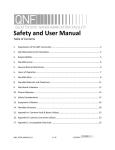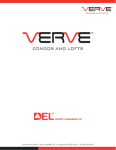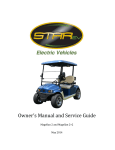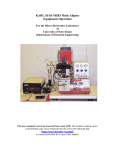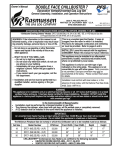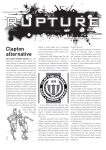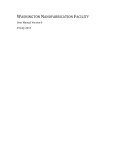Download Microfab User Manual - Utah Nanofab
Transcript
Application-Specific Instructions RESEARCH USER MANUAL for the UTAH NANO SCIENCE & ENGINEERING LABORATORIES ENCOMPASSING: MICROFABRICATION LABORATORY AND SURFACE ANALYSIS & NANO IMAGING LAB micro and nano Science & Engineering Labs August 2006 1 General Information (for all lab members) TABLE OF CONTENTS GENERAL INFORMATION INTRODUCTION……………………………………………………………………………… 3 ORGANIZATION OF THIS MANUAL AND YOUR RESPONSIBILITY ACKNOWLEDGEMENTS CONTACTS……………………………………………………………………………………. 4 LABORATORY LAYOUT AND EVACUATION MAP …………………………………… 5 LABORATORY POLICIES & PROCEDURES…………………………………………….. 6 LABORATORY ACCESS………………………………………………….. USER ACCESS FEES………………………………………………………. BUDDY SYSTEM…………………………………………………………... PROCESS DEVELOPMENT……………………………………………….. TRAINING PROCEDURE & EXPECTATION……………………………. EQUIPMENT UTILIZATION………………………………………………. TOOLS……………………………………………………………………….. 6 7 8 9 9 10 11 TAKING CARE OF “YOUR” LAB………………………………………………………….. 11 CLEANING THE LABORATORY………………………………………… 12 GOWNING………………………………………………………………….. 12 Restrictions Clothing Requirements LABORATORY SAFETY…………………………………………………………………….. 15 TOP TEN LABORATORY RULES EMERGENCY PROCEDURES ELECTRICAL………………………………………………………………. 16 FIRE…………………………………………………………………………. 16 FIRST AID…………………………………………………………………… 18 BUILDING PROBLEMS…………………………………………………… 19 ALARMS……………………………………………………………………. 20 DISCIPLINARY ACTIONS……………………………………...………………… 20 SECTIONS RELEVENT TO SPECIFIC PROCESSES PHOTOLITHOGRAPHY: CHEMICAL SAFETY PROCEDURES ……...……………… MATERIAL SAFETY DATA SHEET (MSDS)…………………………… STORAGE………………………………………………………………….. HANDLING……………………………………………………………….... TRANSPORT...…………………………………………………………….. SPILLS……………………………………………………………………... DISPOSAL…………………………………………………………………. DANGEROUS LIGHT SOURCES………………………………………… 21 21 22 22 23 23 24 25 PVD SYSTEMS: HANDLING CRYOGENIC MATERIAL…….. …………………...…… 25 LIQUID NITROGEN (LN2)……………………………………………….. 25 PLASMA BASED SYSTEMS: PRESURRIZED GAS…….. ……………………...…..…… 26 TOXIC GAS ALARM SYSTEM………………………………………….. 26 COMPRESSED GAS CYLINDERS………………………………………. 26 SURFACE SCIENCE & NANO IMAGING LABORATORY..…………………...…..…… micro and nano Science & Engineering Labs August 2007 2 27 Application-Specific Instructions INTRODUCTION Utah’s micro and nano Science and Engineering Laboratories are interdisciplinary facilities supporting innovative education, research, and technology transfer. Located at the University of Utah, these multi-purpose facilities provide the clean environment, expertise, and equipment necessary for micromachining, microfabrication, and nano-scale semiconductor materials & device research. The teaching laboratories strengthen undergraduate microfabrication curricula and train graduate students from across the University of Utah campus in the fundamentals of micromachining, microsystems design and characterization, microsensors and actuators, and microelectronic devices. The research laboratories offer an extensive array of process equipment with advanced capabilities in pattern generation, photolithography, thin film deposition and etch. Characterization capabilities include surface analysis and nano-imaging. Researchers from the School of Medicine and Colleges of Engineering, Science, Pharmacy, and Mines collaborate in the research and development of biological and chemical sensing micro arrays based on nanotechnology, among other applications. Researchers are developing Micro electro-mechanical systems (MEMS) including neuroprosthetics, devices with optical and microfluidic functions, harsh environment sensors, and micro power sources such as fuel cells and solar cells. These laboratories support the University of Utah mission to stimulate and grow the economy in the state of Utah by innovating and transferring developed technologies into the private sector. The labs support and enable many government/industry/university collaborations. ORGANIZATION OF THIS MANUAL & YOUR RESPONSIBILITY All lab members are responsible for demonstrating understanding of the General Information section of this manual, and will be accountable for adhering to general lab policies and procedures. Additionally, there are specific sections of this manual that cover topical areas of process and instrument function. You are required to demonstrate competence in the following areas, depending upon your level of research need: Chemical safety (for wet deposition and etch operations), Photolithography (including safe use of developers), CVD/PVD (including vacuum system understanding and use of pressurized gas sources, cryogenics in the case of some sputtering systems), and Surface Analysis tools. Acknowledgments We offer our appreciation to the people at Washington Tech Center for their mentoring, and offering assistance in helping us build systems promoting safety and lab utility. micro and nano Science & Engineering Labs August 2007 3 General Information (for all lab members) CONTACTS Director Florian Solzbacher Associate Director Ian Harvey Email Phone [email protected] 801-581-6045 [email protected] 801-585-6162 Laboratory Staff You may reach staff members by calling the nanofab reception desk at 801-581-6210 or at the shared staff number 801-581-5676. For general information you may email [email protected]. To get contact information for specific staff members, please refer to our website: http://www.nanofab.utah.edu Environmental Health & Safety (EH&S) Chemical Spills, Exposure, Odors 581-6590 Building/ Facilities (e.g., for concerns about room temperature or water leaks) Plant Operations (24hours/7days) 581-7221 Emergency (24hours/7days) Poison Control (call here first in case of chemical exposure) University Police Medical/Fire/Police Emergency micro and nano Science & Engineering Labs August 2007 581-2151 585-2677 9-911 6 General Information (for all lab members) Laboratory Layout and Evacuation Map micro and nano Science & Engineering Labs August 2007 5 General Information (for all lab members) LABORATORY POLICIES & PROCEDURES Established laboratory policies provide everyone with a safe and effective working environment conducive to high-quality research and learning. Laboratory members are part of a larger community that exists in this shared facility. As such, we expect a commitment from all members of the community (students, staff, faculty, and industrial visitors) to act in a manner based on courtesy, civility, mutual trust and respect. All members of the community should be aware of the potential impact of their actions, and strive to conduct themselves at the highest professional level. Access Hours All lab members must card in to the lab for entry and use of the lab. Visitor Hours (with Staff permission): 8:00 a.m. – 5:00 p.m. Visitors must sign in the guest log. Teaching Lab Hours 7:00 a.m. – 9:00 p.m., Monday- Friday, for students registered in related courses Research Lab Hours 7a.m. – 6p.m., Monday - Friday for all new research lab members. After adequate training and three months of full-time laboratory use have been successfully completed, a research lab member may request 24/5 access. To receive 24/7 access, a research laboratory member will be required demonstrate a community-minded attitude and demonstrate understanding in critical laboratory infrastructure, such as alarm systems, HazMat handling, and emergency procedures. All members who access the facility after normal business hours will be required to comply with the Buddy System Policy, described in this manual. Building Hours The Merrill Engineering Building is open from 6a.m. – 10p.m., 7 days a week. To obtain access to the building outside of the normal business hours, contact the College of Engineering Dean’s Office at (801) 581-6911. Laboratory Access The following steps must be followed in order to obtain access to lab and become a research laboratory member: micro and nano Science & Engineering Labs August 2007 6 General Information (for all lab members) On-Campus Lab Member • • • • • • Complete and sign a user agreement form and a project form (found at microfab.utah.edu) and submit to Brian Baker in the microfab, 1280 MEB or Monica Heaton in 1680 Warnock. Read Nanofab User Manual and complete on-line safety exam and safety training. Upon passing the safety exam, laboratory members will be entered into the card access system and project(s) for billing will be identified. Access hours to the lab are determined by training level and user status. For safety reasons, you must not work alone outside of general lab hours. Use of the buddy system is mandatory at all times, and outside of 7a.m.-6p.m. you are responsible for scheduling your own buddy. Laboratory members can log onto microfab.utah.edu to reserve equipment. Reservations can only be made for equipment that you are trained on and authorized to use. All lab members are required to attend a Safety & Policy Training Workshop held once each year. This training can be taken in lieu of other mandatory training in the College of Engineering. Off-Campus Lab Member • • • • • • • Complete an Indemnification and user agreement form (found at microfab.utah.edu) and submit signed forms to Brian Baker in the microfab, 1280 MEB or Monica Heaton in 1680 Warnock. Read Nanofab User Manual and complete the on-line safety exam and safety training. Obtain a key card from Brian Baker. The cost of the key card is $5.75. Upon passing the safety exam, you will be entered into the card access system and a project(s) for billing will be identified. Laboratory members can log onto microfab.utah.edu to reserve equipment. Reservations can only be made for equipment that you are trained on and authorized to use. All lab members are required to attend a Safety & Policy Training Workshop held once each year. Access hours for non-University laboratory members is 8a.m.- 5p.m. or by special arrangement. User Access Fees (Billing system) Laboratory fees are divided into two categories: On-campus rates and Off-campus rates. Laboratory training sessions are provided at no charge to new members. Laboratory staff are available for process work on contract basis. This arrangement is appropriate for any researcher unable to conduct the work themselves. These requests are considered on a caseby-case basis. Work request forms for microfab staff are available on-line. Laboratory rates are subject to change. Current rates are posted at http://microfab.utah.edu. micro and nano Science & Engineering Labs August 2007 7 General Information (for all lab members) Microfab Lab University * $535 $45/hour $35/layer $45/hour External Monthly Maximum Lab Access N/A Lab Access Rate (to monthly maximum) $67.50/hour Mask Making (per layer) $52.50/layer Technical Support $67.50/hour Consumables, Precious Metals & Gases (costs billed per item used) Reservation fee $25 $37.50 (waived if equipment is used) Failure to Card-out fee (2 hr minimum) $90 $135 * Other academic institutes must pay University of Utah overhead rates of 50% Rates are subject to change. Surface Analysis & nano Imaging Lab University* External Basic Lab Entry $15/hour $22.50/hour XPS Equipment Use $45/hour $67.50/hour Technical Support $55/hour $82.50/hour Consumables (costs billed per item used) Failure to Card-out fee (2 hr minimum) $30 $45 * Other academic institutes must pay University of Utah overhead rates of 50% Rates are subject to change. "Buddy" System A “buddy” refers to having another authorized lab member while working in the lab. This person needs to be capable of helping in the event of an emergency and aware of his or her responsibility to check up on the well-being of his or her counterpart, on a regular basis. • • • • The University of Utah, College of Engineering mandates that researchers working in labs containing hazards must not work alone in the lab suite. Trained and authorized lab members can work in the lab outside of general access hours (7am - 6pm M-F) if at least one other authorized lab member capable of helping in an emergency is present in the lab. Work with your buddy to ensure regular verification of status. (It is not necessary for both of you to be in the same room at the same time, just both in the microfab, regularly checking up on each other. When working with HF, BOE, or piranha, you must have a buddy present in the same room.) You are responsible for coordinating your work such that other lab members are present. Lab members violating the buddy system rules will lose laboratory access privileges. micro and nano Science & Engineering Labs August 2007 8 General Information (for all lab members) Process Development Students and members of the microfabrication lab can propose to develop and characterize new processes that will be made available to all members of the lab. You can find a brief proposal template at microfab.utah.edu. Proposals should be submitted to the microfabrication lab manager and / or course instructor. If your proposal is approved, based on general application of the process, you will be set up on a project for “Process Tool Development”. Lab fees can be waived for this work if it is of clear, general benefit to the microfab lab and its members, but you will still be required to log your time. All projects will have a projected end date. All developments will follow with a report and procedure manual formatted and ready for addition to the on-line microfabrication technology library. Training Procedure & Expectations Laboratory staff will provide training on all equipment. Observing another member does NOT constitute training. Only laboratory staff can authorize lab members on equipment. It is recommended that any prospective member should take a formal laboratory course, such as Fundamentals of Microfabrication Processing (ECE 5221/ME 5050) or Semiconductor Devices (ECE/MSE 5201). In the absence of such training, it is incumbent upon the lab member to become thoroughly familiar with SOP’s (found on-line), and with the basic operating principles of the tool. Training typically consists of two sessions, a basic-training session and a follow-up session. The basic training session is taught first by laboratory staff. Safety precautions and proper equipment operations are described and demonstrated. Lab members should feel free to ask any questions during this session. The second session is the follow-up session where the lab member demonstrates the ability to operate the equipment competently with the lab member’s own substrates. Staff will reserve the equipment in advance of the training session. Laboratory staff will provide minimal assistance to ensure the safe and proper operation of the equipment. The laboratory staff may quiz lab members. The follow-up session must be completed within one month of the basic-training session or the lab member will have to repeat the basic training session (at the technical staff rate). If the lab member can demonstrate the knowledge and ability to operate the equipment, they will be added to the approved user list for that equipment. Use of equipment and instrumentation is a privilege available when competence is consistently demonstrated. All lab members are required to card swipe into the lab and will be billed at the lab access rate for both training sessions. Laboratory staff may request a lab member to repeat training following an extended period of time without practice. If a lab member does not enter the facility for 1 year, they may also be required to complete the lab safety test again. If you feel “rusty” using a piece of equipment, ask for assistance. micro and nano Science & Engineering Labs August 2007 9 General Information (for all lab members) Equipment Utilization Equipment can be used only for its designed purpose and in a manner for which it was intended. Any malfunction of the equipment must be reported immediately to the laboratory staff. If staff members are unavailable, leave a message in the equipment logbook and email a message to [email protected]. A voice mail message may be left by calling 581-5676. Standard operating procedures, if available, for a given tool are posted at http://microfab.utah.edu/ under “Lab User Functions”. ALL MATERIALS BROUGHT INTO THE LAB MUST BE APPROVED. Permission from the laboratory staff is necessary before introducing any non-standard substrates or materials into the equipment. A new chemical request sheet is available on-line. Modifying or altering any piece of equipment without authorization from the laboratory staff is prohibited. Failure to abide by this policy can result in loss of access privileges and any resulting damage will require PI and/or student to pay for repair costs. In general, leave the lab cleaner than you found it! Equipment Reservation Courtesy & Expectations Lab members must log onto http://microfab.utah.edu/ under “Lab User Functions” to reserve time on reservable equipment. Select “reserve resource” to select equipment, date, and times to be reserved. Special permission must be given to any lab member that wishes to reserve a piece of equipment for more than 48 consecutive hours. Equipment “Squatter” Policy: Lab members may reserve up to 16 hours of Equipment time per week during normal working hours (7 a.m. - 6 p.m. Monday-Friday). Lab members may reserve up to 48 hours total equipment time per week. If a tool is not scheduled “today” then lab members may sign up for time beyond their 16-hour weekly limit. The microfab staff does not actively monitor the reservation schedule, so if you are having trouble getting time on a tool, please attempt to work out an equitable solution with the other lab members, or failing this, notify us so that we can remedy the situation. Lab members should cancel any unused reserved time as soon as possible so that it will be available to other members. If a reservation is not cancelled, lab members will be charged for use of the equipment as the reservation has made it unavailable to other members. This appears as “noncancellation” on a bill and is not part of the monthly cap. If lab members are more than 30 minutes late to begin processing on any piece of equipment, the member looses the reservation, and the equipment is open for any lab member for the remainder of the reservation period. The member will be charged a fee for failure to cancel reservation. This is also referred to as “non-cancellation” on the monthly bill. micro and nano Science & Engineering Labs August 2007 10 General Information (for all lab members) Any equipment that is left unattended while in process should be labeled with contact information of the person that is running the equipment. If that person cannot be contacted within 30 minutes using the posted information and the process and reservation time is completed, the substrates can be removed from the equipment. If a researcher is finished, another lab member can use the equipment for the remainder of the original reservation time. If you have questions about an unattended experiment, ask microfab staff for assistance. Any unattended, unlabeled experiments are undertaken at your own risk! Hand and Power Tools Various tools are located in the laboratory. The tools are a shared and essential resource to keep the lab operational. • • • • Using the available tools is a privilege. Treat all tools with care and use them in a safe manner for their intended purpose. Return all tools promptly and in a clean, undamaged condition to their proper drawer and storage area. Report lost or damaged tools to laboratory staff as soon as possible so they can be repaired or replaced. Tools and test equipment may not be removed from the microfab. Taking care of “your” Lab Laboratory cleanliness is ESSENTIAL to the safe and successful operation of the microfabrication lab. • • • • Clean up any mess made and supplies used during lab sections and/or research activities. This includes items such as chemicals, glassware, hot plate surfaces, spinners, wet benches, empty chemical bottles, etc. Violations can result in loss of access privileges. It is especially important to clean up the photoresist off the spinner chucks each time you use these. Failure to do so results in the spinner going down hard for maintenance when the resist solidifies in the chuck vacuum (your wafer and your colleague’s wafer will fly off and break). Improperly labeled chemicals left out will be disposed. If the composition is "unknown", then it will have to be analyzed and disposed of by EH&S. Any disposal fees will be added to your lab fees. If you have a mess that is difficult or dangerous to clean, ask a microfab staff person for advice and/or assistance. micro and nano Science & Engineering Labs August 2007 11 General Information (for all lab members) Weekly Lab Clean Assignments 1. Weekly time is set aside for lab clean and maintenance. No fees will be incurred by lab community members who are assisting with the clean, as long as your lab clean time is logged in the log book. 2. Assignments for lab clean are determined by the number of hours each lab member spends in the laboratory during the month, two months prior to the lab clean month. For example, if you spend more than 12 hours in the lab during June, you will have a lab clean assignment in August. 3. At least one staff member will be available in the lab during the clean. That person is there to advise and retrieve any needed supplies. 4. In case of an emergency, contact staff in charge as soon as possible for assessment of the situation. 5. Lab cleans are to be done between 8am and 10am every Tuesday morning (except holidays). It will take at least one (1) hour to do a reasonably thorough job, and thus you should show up NO LATER THAN 9AM. 6. You are responsible for checking the lab clean schedule for your assignments, posted for each month on the bulletin board in the hallway outside the laboratory. 7. If you miss a lab clean or fail to complete the entire lab clean task, you must participate in the next scheduled lab clean or arrange another time with laboratory staff. Failure to participate in this program can result in loss of member privileges. 8. Checklists describing the cleaning task for the different areas are located in the Lab Clean Notebook in the gowning area and also on the website. The tasks should be completed in the order listed. a. It is your responsibility to learn the task for the area you have been assigned. Student mentors and/or staff should teach the new students how to perform the assigned tasks. 9. When you finish your cleaning duties, sign-out in the Lab Clean notebook and return the task checklist to the designated location in the gowning area. GOWNING While the Surface Lab can be accessed from the MEB hallway, everyone entering the microfab must enter through the main lab entryway for suite 1280, next to the EMCB tunnel. Use the labeled card swipes as: lower card swipe for course students; upper card swipe for research lab members. Leave coats, backpacks, and personal items on the shelving located at the main entrance to the lab. In order to proceed further into the laboratory, the lab member must adhere to the following requirements: micro and nano Science & Engineering Labs August 2007 12 General Information (for all lab members) Restrictions • • • • • Open-toe shoes and sandals are prohibited. Shoe covers are required in all areas of the microfab (not required in the surface lab). A full “bunny suit” is required if you are wearing shorts. Skirts and dresses are not appropriate as they do not provide any protection from potential chemical spills. Legs must be fully covered. Use of contact lenses in the laboratory is discouraged, as chemicals can become trapped between your eye and the lens. Safety glasses must be worn at all times. Food and drinks are not allowed anywhere in the laboratory, including entry way. Cardboard, packing materials, pencils, and other particle-generating materials are prohibited in the cleanroom. Clothing Requirements General clothing requirements for basic protection against spills, and to protect the lab from your contamination: Lab Coats • Lab coats are required for all areas. • Research lab members may purchase their own white lab coat to use. This personal coat must be labeled with member name. Lab members who maintain a permanent white lab coat in the lab should change and/or launder their own lab coat on a regular basis. • Gray coats are to be shared by research lab members. Users of gray lab coats should not expect to label coat or retain any items left in the pockets. • Dark blue coats are for students in enrolled lab courses. • Light blue lab coats are for laboratory staff. Other Clothing Requirements • Safety glasses are provided and required in all areas. Lab members may purchase and maintain their own safety glasses. There will be zero tolerance for people who are found using wet-bench areas without proper safety glasses and proper protective clothing (see below). Members who wear prescription glasses are required to wear safety glasses over prescription glasses. • Use a disposable bouffant to cover hair. • Shoe covers are required in all areas of the microfab. When entering or leaving equipment bays use the sticky mats to keep the facility cleaner. micro and nano Science & Engineering Labs August 2007 13 General Information (for all lab members) Gloves • Gloves MUST be worn at all times while in the laboratory. • Blue (Nitrile) gloves are used ONLY for non-chemical operations. - Typical uses include working on vacuum systems, protecting substrates from contamination, operating microscopes, operating equipment. - Because these gloves don't get contaminated with chemicals, you are permitted to operate door handles and lab equipment with these gloves. • White (Nitrile) gloves are to be used on top of blue nitrile gloves for all chemical operations. - Nitrile gloves do NOT protect against all chemicals so additional gloves might need to be worn over the nitrile gloves for protection. - Typical chemical operations are developing photoresist, using KOH, using mild etchants, using organic solvents or chemicals, etc. - NEVER operate door handles or equipment while wearing white gloves. Residual chemicals on the gloves can contaminate surfaces and cause serious injury to yourself and others, and this will carry consequences to your access privileges. • When handling acids, heavy rubber gloves are provided for re-use. Wear rubber gloves over white nitrile gloves. Always remove these gloves by pulling at the fingers, to avoid contamination of the sleeve. • Never touch your face, nose, mouth, etc. while wearing gloves in the microfab. This contaminates you and the gloves! Gloves are meant to protect you; but also to protect the samples, and equipment from contamination. • Use the proper type of gloves for the specific activity. The proper type of glove will be listed in the SOP for the process. The lab does not have any gloves that are safe for immersion. Always use the appropriate tong, dipper, or tool to place in or remove an item from a chemical bath. NEVER use a gloved hand to hold an item in contact with chemicals. • Thoroughly rinse and clean non-disposable acid gloves when you are finished with them, and remove them carefully by pulling gently at the fingers or outside the cuff. Do not use a contaminated glove to grip the inside of the other glove during removal or at any other time! • Note: Some people are allergic to latex. Summon medical help (Poison Control 1-2151) if a severe allergic reaction occurs. Specialty Clothing • Acid/base resistant aprons, face shields, and general-purpose goggles are available. These items should be worn for processing requiring the use of wet chemicals. micro and nano Science & Engineering Labs August 2007 14 General Information (for all lab members) GENERAL LABORATORY SAFETY Working in the laboratory while pregnant is not advisable. Lab members shall not be under the influence of drugs or alcohol while using the lab. The following safety rules and procedures are for the protection of all laboratory members and staff members. Laboratory members should use common sense when thinking of safety and how their actions will affect other laboratory members. These rules must be read, understood, and practiced at all times. Laboratory staff members are available to answer any questions. If you are aware of an unsafe condition, please notify a staff member immediately. Remember, there is no excuse for not following these safety rules. TOP TEN LABORATORY RULES 1. If you don’t know, ask! All members of this facility agree to abide by the rules and policies of the microfab lab. 2. Lab members may only access equipment for which they are trained and authorized. Laboratory staff will provide training on all equipment. Members report all equipment and facility problems to laboratory staff. Lab members log their time and application details in supplied log books. 3. Laboratory staff must approve all new chemicals and equipment before they are brought into the laboratory. An MSDS must be provided for new materials. For all non-standard materials, get staff approval for how these will be used. (Reference “Chemical Safety Procedures” section.) 4. No food or drink in the laboratory or gowning area. Members are encouraged to wash their hands immediately after leaving the laboratory. 5. Lab members must maintain a clean work environment, be considerate of fellow members, and leave their work environment in a neat and clean condition. “We are all in this together.” 6. Lab members must wear safety gear appropriate for the process, especially with acids. Lab coat, gloves, safety glasses, booties and bouffant are required in all microfab areas. 7. Do not bring solvents, especially wash bottles to the acid benches. Solvents include acetone and alcohols. All acid work must be done in acid benches. Solvents must not be disposed in any drains. 8. All chemicals not in their original container must be labeled with the contents, date, name of lab member, and contact information. Markers and labels are provided in the lab for this purpose. 9. Lab members must store and dispose of chemicals properly. A waste container is provided for solvents. DO NOT MIX ACIDS IN SOVLENTS. 10. All members are responsible for politely reminding fellow lab members of safe laboratory practice, if fellow members are seen engaging in activities that may endanger themselves or others. The observer is expected to immediately report the incident to laboratory staff. micro and nano Science & Engineering Labs August 2007 15 General Information (for all lab members) EMERGENCY PROCEDURES These procedures are required to be read and understood by all course students, researchers, and staff. If there is a serious accident that requires immediate medical attention, call 9-911. Never move an accident victim unless they are in imminent danger of further injury. Electrical Electrical hazards exist in the laboratory. Electrical hazards can result from the improper use of electrical equipment, the use of damaged electrical equipment, or exposed electrical circuitry and wiring. Electrical Guidelines Laboratory members are expected to conduct themselves in a safe manner when using high voltage equipment and follow these basic guidelines. • Laboratory staff or University Plant Operations personnel perform all electrical wiring. • Report all problems to the laboratory staff. • Do not overload circuits. • Use equipment shielding properly to avoid radiofrequency (RF) burns. • Know the locations of the emergency offs (EMOs), circuit breakers, and electrical disconnects associated with the equipment in use. EMOs can be found on most major pieces of process equipment. Electrical Shock • Do not grab an electrocution victim; the rescuer can be electrocuted. • Evaluate source of shock and disable the power source if possible. • Request medical attention and inform the laboratory staff. • Administer CPR if necessary and trained to do so. Power Failure • Turn off the equipment you were using (EMO button) to prevent further damage. • Completely close all hoods to help contain fumes. • Exit lab. • Report the power failure and any processes left behind to laboratory staff. Fire Fire hazards exist in the laboratory. Laboratory members are expected to educate themselves about the potential fire hazards associated with the chemicals and processes they are using in the laboratory to avoid injury. micro and nano Science & Engineering Labs August 2007 16 General Information (for all lab members) Fire Prevention Fires in the laboratory can result from the ignition of any combustible material, including flammable gases and solvents. The ignition of chemical solutions on hot plates is a major cause of laboratory fires. • • • • • • Obtain permission prior to using any new chemical procedure. Speak with a staff member if you need to heat flammable organics. This may be done with a heated water bath. Avoid water around electrical appliances. Keep paper and other combustible materials away from ovens or furnaces. Keep rags and wipes soaked in any chemical away from heat to avoid auto-ignition. Do not use flammable materials or chemicals near the burn box. Fire Procedure Members should remain calm and conduct themselves in an orderly fashion when responding to a fire alarm. Familiarize yourself with the location of all fire alarms, fire extinguishers, and emergency exits in or near the microfab lab. Clothing on Fire • Roll the victim on the ground to smother the fire, or if easily available, use safety shower to extinguish the flame. • Summon medical help by dialing Emergency Dispatch at 9-911 • Notify the laboratory staff. Controllable Fire • University regulations require training to use fire extinguishers, and a “buddy”. • The microfab facility is equipped with ABC fire extinguishers. Make certain you are familiar with the location in your work area. • Turn off electricity for electrical fires. • Use the nearest fire extinguisher aimed at the base of the flame using a sweeping motion. • Report the fire to laboratory staff. • Call the Police at 9-911 if necessary Uncontrollable Fire or Explosion • Pull nearest fire alarm and alert people in the lab to evacuate building. • Assist injured people. • Close doors to isolate the fire. • Silane (SiH4) fires can only be extinguished by turning off the gas at the source. • Report fire to laboratory staff and call Police at 9-911 as soon as possible. micro and nano Science & Engineering Labs August 2007 17 General Information (for all lab members) First Aid Minor injuries can be treated with first aid supplies located in the first aid box at the entrance of the laboratory. Contact the laboratory staff regarding any injury and complete an incident report. For serious acid burns call the Poison Control Center, 581-2151. They will tell you which hospital to go to and they will notify the hospital that you are coming. For Serious injuries, call 9-911 Chemical splash on the skin or in the eye • • • • • • • Emergency showers / eye washes are located in each of the laboratory processing bays. Make certain you know the location of the nearest emergency shower / eye wash station to your work area. Immediately begin flushing the affected area with plenty of water. Remove any contaminated clothing as you continue the rinsing process. Rinse for 15 minutes for most acids/bases (except HF/BOE). Prompt medical attention should be sought after the initial aid is provided Request medical attention and inform the laboratory staff. Fill out an incident report. BOE or HF on skin (Buffered Oxide Etch contains HF, hydrofluoric acid.) • • • • • Procedures & antidotes are located at each acid station and on the microfab website. Flush with copious amounts of water for 5 min. Apply Calcium Gluconate gel to the affected area (except for eyes) during call to Poison Control. DO NOT TOUCH THE VICTIM WITHOUT WEARING APPROPRIATE PROTECTIVE CLOTHING. Call University of Utah Poison Control Center, 581-2151. They instruct in procedures, and will notify the hospital of your pending arrival. Transport victim to the Emergency Room at the University of Utah Hospital, take MSDS with you. Poisonous Gas Inhalation • Remove the victim from the contaminated environment if possible to do safely. A selfcontained breathing apparatus (SCBA) is located near the lab entrance. • Call University of Utah Poison Control Center, 581-2151 • Summon emergency medical personnel. • Loosen their clothing to facilitate breathing. • If the victim has stopped breathing, use CPR (if qualified). • Request medical attention and inform the microfab staff. micro and nano Science & Engineering Labs August 2007 18 General Information (for all lab members) Ingested Poisons • Call U. of Utah Poison Control Center, 581-2151. Seek instructions. • Follow directions on the MSDS. Major Thermal burns • Second and third degree burns: This is a burn with blisters or charring that penetrates the skin. Also, first degree burns over large areas: • Summon emergency medical help by calling Police at 9-911 • DO NOT cover the wound with either a dressing or a bandage. • Notify laboratory staff and file incident report. Recommendations for Minor Thermal burns • First and second degree burns: This is a burn that is red or results in minor blistering of the skin. A Minor burn only covers a small area of the body. • Run cold water over the burn. • Use a burn cream and cover with a sterile dressing. • If necessary seek medical help. Major Injury from explosion, fall, etc. • Initiate life saving measures if required. For severe bleeding apply direct pressure. • Call Police at 9-911 • Do not move the victim unless there is immediate danger of further harm AND it is safe to approach them. • If the victim stops breathing, immediately obtain assistance from someone who knows CPR. • Remain with the person until medical help arrives. • Notify laboratory staff. Building Problems If you notice any problems related to the building infrastructure; i.e. water leaks, gas leaks, electrical or lighting problems, and problems with liquid nitrogen, gaseous nitrogen, deionized water, fresh air flow, heating/air conditioning, exhaust air, plumbing: • • • Shut off source of problem if able and if it is safe to do so. Report problem to laboratory staff for immediate attention If laboratory staff are not available, contact the University Plant Operations personnel at 1-7221. micro and nano Science & Engineering Labs August 2007 19 General Information (for all lab members) Alarms in the Laboratory Several alarm systems are located in the laboratory for the safety of the lab members, staff, and all individuals located in the Merrill Engineering Building. Should you hear a fire or toxic gas alarm sound, evacuate the building immediately. The following alarm systems are currently in the laboratory: Alarms that require evacuation from the building • Fire • Toxic gas monitor Alarms that require contacting lab staff • Burn box • Furnace over temperature DISCIPLINARY ACTIONS The safety rules and policies in the microfab and Surface Analysis & nano Imaging laboratories are necessary in order to maintain a safe and productive working environment. Many of these guidelines are simply common sense and require consideration of other lab members. Others require specific knowledge of proper equipment use, chemical handling or lab procedure. It is the responsibility and obligation of ALL members to be fully aware of safety policies and to be trained by the laboratory staff on particular pieces of equipment, chemical handling and lab procedure required for their work. This manual is not intended to be exhaustive. All policies and guidelines are subject to revision dependent upon laboratory procedural changes. Be aware of new or changing lab guidelines. Please encourage safety and proper lab usage among the other lab members and report any serious violations of the guidelines or policies to the laboratory staff. If you see someone engaging in unsafe practices, let them know that their behavior affects you and your ability to safely and effectively carry out your own work. No one should think “that’s none of my business”, since all equipment is shared, and everyone’s actions––good or bad––impact others. The following procedures will be used to discipline individuals who do not comply with the rules and policies: Violations may be either safety or non-safety related. • Safety violations include activities that endanger either the safety of the individual or other members of the facility, including not wearing protective gear when using chemicals. This micro and nano Science & Engineering Labs August 2007 20 General Information (for all lab members) • particular example will result in immediate expulsion from the lab for a period not less than one week. Non-safety related violations include activities that do not comply with rules, regulations or policies intended for the organized and efficient operation of the facility, including improper use of equipment placing equipment function at risk. If a tool is broken through negligence or incompetence on the part of the student, and the student does not readily acknowledge the situation by notifying staff, then the project may be held financially liable and the student may be expelled from the lab. Infractions will be treated on an individual basis, depending upon severity, risk or consequences of the action, and the judgment of the staff regarding the attitude of the offender and the reasonable level of expectation that the individual should have known better. Serious infractions will result in loss of laboratory privileges. Regained access if any, will be subject to the judgment of the staff in consultation with the student’s advisor in setting both conditions and timeframe. Reading Sections Relevant to Specific Processes You are responsible to read the following sections when your application needs require a higher level of understanding. The following sections are organized for users of the following areas: Photolithography/Wet chemistry; PVD/CVD/Plasma; Surface Science Photolithography: Chemical Safety Procedures A variety of chemical hazards exist in the laboratory. Laboratory members are expected to educate themselves about chemicals, take the necessary precautions associated with chemicals, and conduct themselves in a safe manner when handling chemicals. We re-iterate that members must not bring chemicals into the laboratory without first obtaining authorization (application is available for upload on the microfab website). We encourage people wishing to bring in chemicals to first discuss their application with the Chemical Safety Officer. The Chemical Safety Officer is also a valuable resource to assist in designing processes which accomplish the process objective using safer materials. Bringing an unapproved material or chemical into the lab is a serious violation. Material Data Safety Sheets (MSDS) The MSDS provides information about the chemical substances within a product, safe handling procedures, first aid measures, and procedures to be taken when the product is accidentally spilled or released. • MSDSs are located in the gowning area of the microfab lab. micro and nano Science & Engineering Labs August 2007 21 General Information (for all lab members) • • • All chemicals must have an MSDS. New or specialty chemicals must be approved by the laboratory staff. A required worksheet is available on the microfab website to facilitate this process. You should be familiar with the handling precautions and hazards associated with your process chemicals and treat them appropriately. Review the MSDS for unfamiliar products. Make note in your notebook when you have reviewed the MSDS sheet, and review the sheets at least yearly. If information in the MSDS does not make sense, please ask for clarification. It is important that all lab members understand the safe use of chemicals in their processes. Chemical Storage • • • • Store and return all chemical bottles to their corresponding chemical cabinets. Stored chemicals are separated into the following categories (See tables for listed inventory). - Solvents - Mineral Acids (hydrochloric, nitric, etc) - Organic Acids (acetic, oxalic, etc) - Bases - Salts All chemicals must be stored in an authorized containment vessel. You may NOT store chemicals in dry boxes, on benches or tables. Clearly label and properly store all chemicals. Label should include the lab member’s name, date, time, phone number, and chemicals involved. Use a "Sharpie" pen to mark glassware. This can be cleaned with methanol or acetone. Never pour a chemical back into its reagent bottle; dispose of excess chemicals or store them in a clean, labeled container. Chemical Handling Be aware of the following guidelines when handling or transporting chemicals. • • • • • • • • Always wear complete safety apparel when handling chemicals - follow instructions. Some chemicals dissolve PVC gloves. It is in your best interest to know which ones - read the MSDS for all chemicals before using. When using hazardous materials, never work alone. Do not taste, smell or touch any chemical, vapor or gas. Use chemicals in areas designed for chemical processing; perform chemical work and keep open chemicals inside the exhausted wet benches or chemical hoods. Do not leave hazardous materials / processing chemicals in glassware when in use. If this is unavoidable, the materials(s) must be labeled for proper identification. Do not leave chemical bottles on the floor or sitting unattended on the wet benches. Never mix acids and solvents (fires can result or KABOOM) Keep solvents and acids/bases in separate workspace. Dispose separately. micro and nano Science & Engineering Labs August 2007 22 General Information (for all lab members) • • • • Do not heat, mix or prepare chemicals without authorized procedures or prior experience. When diluting acid, Always add acid to water. Never the reverse, as the risk of acid splashing out of the container or generating a violent reaction is very high. A “memory trick” helps here––Alphabetical order: Acid to Water. Never touch any equipment or door handles while wearing specialty chemical gloves. This is a required safety courtesy to others and will protect yourself as well. When you are finished, please make sure to keep the front 12 inches of the chemical hood free of bottles, glassware, etc. Clean up your mess!!! Chemical Transport • • • All chemicals must be transported using either a chemical cart or a bottle carrier. Short moves within the work area should have the attention of both hands in appropriate gloves. Bottle carriers are for transport of chemicals and not for storage. Specialty chemicals can be moved into and out of the microfab facilities with authorization of the microfab staff only. Chemical Spills Spills inside the wet bench may be washed away with the water spray nozzle. Spills outside the wet bench require the following: Major Spill 1 Evacuate laboratory. • Attend to injured people • If spill is flammable, turn off sources of heat. • Seal off affected areas. 2 Call EH&S to report spill (1-6950), request HAZ-MAT team. • • After hours call Campus Police at 5-2677. Notify laboratory staff. Minor Spill (One that can be dealt with by laboratory staff without outside assistance.) 1 Alert people in the area. • • • • Wear protective clothing. Avoid breathing vapors. Use appropriate spill kit for the material to be neutralized (i.e. Acid, Base, or Organic) Absorb the spill using the spill pillows located in the safety area near lab entrance and photolithography bays. 2 Notify a laboratory staff member. micro and nano Science & Engineering Labs August 2007 23 General Information (for all lab members) Mercury Spill (e.g., broken mercury thermometer or mercury lamp) • Alert people in area. • Evacuate the area. • Notify laboratory staff. Waste, Chemical & Sharps Disposal Clean up completely and dispose of solutions properly when finished with a process. • All beakers, graduated cylinders, etc. must be emptied, rinsed and stored properly at the end of each use. Rinse out acid, base and oxidizer bottles a minimum of three (3) times with DI water. There are now five types of solid waste collection in the microfab: • • • • • • Regular trash: For uncontaminated, non-infectious; gloves, wipes, bags, etc. Do not use for sharp metal or any silicon or any glass. Photoresist trash (one in each photobay): For photoresist contaminated gloves, wipes and plastic pipettes. Whole or broken wafers must be cleaned and placed in the Broken Glass Boxes. Broken Glass Boxes (cardboard w/plastic liner): For uncontaminated, non-infectious; glass bottles and vials (less than one pint), microscope slides and cover slips, Pyrex lab ware, and silicon wafers. Infectious Waste (red plastic w/Biohazard symbol): For metal sharps, needles, syringes, and razor blades. Empty Chemical Bottle Bin: For all empty chemical bottles one pint and larger, draw a line through the chemical name (deface). All bottles and lids must be clean (lid goes in regular trash). For acid or base, rinse three times with water. For acetone, isopropanol, and methanol; empty into waste solvent container then rinse three times with water. For photoresist and solvent based developers; clean with acetone then rinse three times with water. Dispose of waste glassware in a cardboard box and tape it shut. Label "Waste Glass" on the outside of the box and place in the trash. We have receptacles available for broken glass labeled “Sharps Waste”. All sharp objects (e.g. broken glass, needles, blades, etc.) must be placed in the designated "Sharps" waste container. Do not put any chemical waste in the Sharps waste container. Disposal of Acids and Bases • All of the wet chemical hoods located in the microfab are plumbed to a neutralization tank. Acids and bases can be poured down into the sink for disposal (but not at the same time). Always run water before, during, and after disposal of acid or base to ensure adequate dilution and rinsing. Domestic water can be used for this purpose micro and nano Science & Engineering Labs August 2007 24 General Information (for all lab members) • Rinse out empty acid bottles a minimum of three (3) times. Also rinse the outside of the empty bottle and the bottle cap. When finished, label the bottles "rinsed" with a sharpie. Dispose of the bottle and cap separately. Disposal of Organic Compounds (Solvents) • • NEVER dump solvents down the drain. Solvent waste is collected in a labeled storage container for proper disposal. The waste storage containers are kept in the wet chemical processing area. Keep the lid closed after use. A $10,000 per day fine can be levied for violation of this practice. Disposal of Contaminated Solid Waste (e.g., towels used for cleaning up materials in the bench) • • If possible, do not discard the waste fully saturated. Allow residual organics to evaporate under a vented hood. Dilute residual acids / bases by using rinse water prior to disposal. Photoresist-contaminated plastic pipettes are collected in a specific containment vessel located by the spin station. Broken glass should be disposed in sharps containers after appropriate rinsing. Photolithography: Dangerous Light Sources: lasers, ultraviolet lamps such as in photolithography tools Safe Operation • • • Avoid looking directly into the beam of light Avoid overexposure to the light Wear safety glasses with appropriate filtering during use of the equipment listed below Light Sources • • • • • UV Source on Mask Aligners, Pattern Generators Electron Beam Evaporator Exposure lamp for mask fabrication Laser on laser ablation and marking tools Light from an Ar plasma in sputter deposition and ion etch tools. PVD SYSTEMS: HANDLING CRYOGENIC MATERIALS Cryogenic hazards exist in the laboratory. Lab members should familiarize themselves with cryogenic materials to avoid injury. Liquid Nitrogen (LN2) LN2 is used throughout the lab. Laboratory members should take all necessary precautions when working with or around LN2. micro and nano Science & Engineering Labs August 2007 25 General Information (for all lab members) • • • • • Only authorized personnel may fill LN2 containers. Only containers designed for transporting LN2 are allowed. Always wear close-toed shoes, long trousers, cryo gloves and goggles when you transfer LN2. Never touch any of the transfer assembly with your bare hands Ensure you have adequate ventilation for any operation consuming or transferring liquid nitrogen. The large volume of gas produced from evaporation of a liquid can displace enough oxygen in a closed room to be dangerous (nitrogen asphyxiation). Do not spill on the floor. Repeated spills will cause accelerated mechanical damage to concrete, etc. PLASMA-BASED SYSTEMS: PRESSURIZED GASES Several toxic and pyrophoric gases are used in the laboratory. Extensive training is required to handle these gases. Laboratory members should familiarize themselves with the hazards of working with these gases and of their locations in case of an emergency. Refer to the Environmental Health and Safety (EH&S) website for the University compressed gas standards. Toxic Gas Alarm System A toxic gas alarm system will detect hazardous gas leaks in the laboratory. The HAZMAT alarm will sound alerting all laboratory occupants to evacuate the building. Compressed Gas Cylinders Compressed Gas Safety • Always wear safety glasses when handling compressed gases. • Make sure all cylinders are properly labeled. • Never direct pressurized gases at a person • Regulators, gauges, and hoses should not be interchanged among gases. • Do not place any item on top of a cylinder that could damage a safety device or interfere with quick closing of a valve. Cylinder Use • You must have permission prior to changing a cylinder. • Never use cylinders that cannot be positively identified. • Inspect cylinder valves for damage or corrosion prior to use. If unsuitable for use, return to supplier • Never lubricate or modify the cylinder valves or gas regulators. • Do not use oil or grease on any part of a tank, valve, or regulator. • Use the appropriate regulator on each gas cylinder. Specific CGA fittings and nuts are designed for use with specific gases, some with reverse threads. (The CGA threads on the micro and nano Science & Engineering Labs August 2007 26 General Information (for all lab members) • • • • • • • regulators are designed to avoid improper or incompatible use.) Do not use any adapter between a gas cylinder and a regulator. If it doesn’t fit, ask a staff member. Always ensure proper ventilation when using asphyxiant or hazardous gases. Never bleed cylinders completely empty. Leave a slightly positive pressure (30-100 psi) to keep contaminants out. Never heat a compressed gas cylinder. Remove the regulator from an empty cylinder and replace the protective cap. Attach a label to the cylinder marked "empty" and place it in the appropriate location for pickup. Notify microfab staff. Do not attempt to refill a cylinder. Do not mix gases within a cylinder. If a mixture is required, order it that way from the supplier. (In-cylinder mixing is prohibited with penalties of heavy fines and jail time) Review the MSDS sheets for the gases you are using. Many of the gases are toxic. All high pressure gases, regardless of toxicity, should be treated with respect. Before using any gas on any piece of equipment, verify that the gas that you think is connected is the one that actually is connected. Proper labeling is required by law. Pressurized Gas Bottle Transport & Storage • • • • • • • • • Do not bring new gases into microfab without prior approval of the safety officer. Handle cylinders of compressed gases as high-energy sources and therefore as potential explosives. When storing or moving cylinders, have the protective caps securely in place to protect the valve stems. When moving large cylinders, strap them to a properly designed, wheeled cart to ensure stability Cylinders must not be dragged or rolled. Cylinders should not lean on one another. Restrain cylinders of all sizes, empty or full, individually by straps, chains, or a suitable stand to prevent them from falling. Cylinders should be stored in appropriately ventilated closets or in an open storage area. Store gases according to chemical compatibility. Never store a cylinder next to a heat or flame source. Do not place gas cylinders such that there is contact with electrical circuitry. ATTENTION MEMBERS OF SURFACE ANALYSIS & NANO IMAGING LAB The Surface Analysis and nano Imaging Lab may be accessed either from the MEB hallway, or through the microfab suite. In either case, lab members must card swipe into the lab, because this lab is billed separately from the microfab (tools other than the XPS are billed at a much lower hourly rate than in the microfab). Members must be trained by the University Surface Scientist to use equipment located in the Surface Analysis Lab. Instruments are delicate, and can be easily damaged by untrained personnel. micro and nano Science & Engineering Labs August 2007 27



























